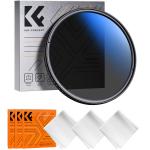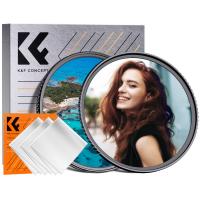Reviews
Good starter ND filter
This filter is a good ND if you've not used one before and want to see if it's a useful part of your arsenal (hint - it will be), or perhaps if you already have one but want better build quality. I have always found K&F products to be of a good solid build and this is no exception, with a nice amount of resistance to the rotation and a decent hard protective case.
My intention for this filter has been lightning photography, but I've sadly yet to get a storm for testing. I haven't noticed any problematic colour casts, but I'm not so concerned with this as it could easily be rectified with minimal processing. I'm awaiting a colour checker so I can test for any shifts at different settings and will update this review with example photos if any problems come up.
You only have to look at the cost of 'professional' variable ND filters to know that the very best results come at a considerably higher price point, and with that in mind you could do a LOT worse than this filter for a budget-friendly option.
As others have noted there is no hard stop when you hit maximum, but I'm not so concerned about such a feature at this price point and I'm not sure I will ever have cause to use it near maximum anyway.
A side note on ND generally - People use neutral density either for longer shutter speeds (smoothing the flow of water etc) or for widening their aperture (shallower depth of field and more bokeh). I find it useful for another purpose specific to mirrorless cameras - sensor dust. The lack of a mirror makes it VERY easy for small specks of dust to get in whenever you change a lens or activate a telephoto zoom (which blows/sucks air directly onto the sensor). So on bright days where you are forced to narrow your aperture to 16 or 22, sensor dust become visible as blobs in the final image. ND allows you to widen your aperture, which renders dust invisible. This is especially relevant if you take images that feature clear open skies. You could clean them up in processing but if you are doing timelapses it can become very problematic to fix.
My intention for this filter has been lightning photography, but I've sadly yet to get a storm for testing. I haven't noticed any problematic colour casts, but I'm not so concerned with this as it could easily be rectified with minimal processing. I'm awaiting a colour checker so I can test for any shifts at different settings and will update this review with example photos if any problems come up.
You only have to look at the cost of 'professional' variable ND filters to know that the very best results come at a considerably higher price point, and with that in mind you could do a LOT worse than this filter for a budget-friendly option.
As others have noted there is no hard stop when you hit maximum, but I'm not so concerned about such a feature at this price point and I'm not sure I will ever have cause to use it near maximum anyway.
A side note on ND generally - People use neutral density either for longer shutter speeds (smoothing the flow of water etc) or for widening their aperture (shallower depth of field and more bokeh). I find it useful for another purpose specific to mirrorless cameras - sensor dust. The lack of a mirror makes it VERY easy for small specks of dust to get in whenever you change a lens or activate a telephoto zoom (which blows/sucks air directly onto the sensor). So on bright days where you are forced to narrow your aperture to 16 or 22, sensor dust become visible as blobs in the final image. ND allows you to widen your aperture, which renders dust invisible. This is especially relevant if you take images that feature clear open skies. You could clean them up in processing but if you are doing timelapses it can become very problematic to fix.
05/11/2024
Guess you like products
Guess you like articles




















